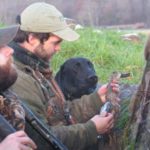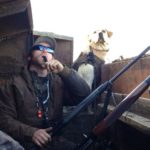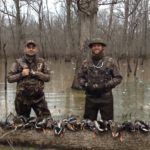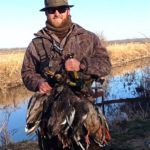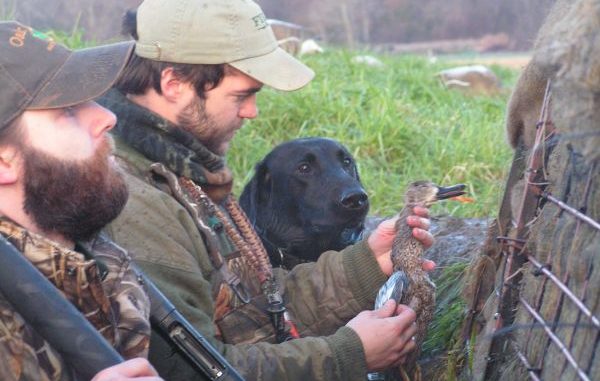
If you’re suffering duck-hunting fatigue, the best is yet to come in Northeast Louisiana. So saddle up for one more month of hunting, and learn from these young guns.
Four big, curious greenhead mallards broke off the flight pattern from a group of 20 or so high-flying ducks and circled high above the decoy spread.
They were obviously intrigued by the duck calls and decoys below. But, even though these four were interested, they were spooky, and this late-season group didn’t look promising.
As the birds made a fourth pass at the decoys from about 60 yards away, Matt Laird sprang from his seat and unloaded on them.
Two of the four folded up and spiraled down toward the water.
Laird turned to the other three hunters in the blind with a big grin on his face and said, “Take ’em.”
Thanks, Matt.
At that time, Matt was a freshman in college, getting ready to play his first season of college baseball at the University of Louisiana-Monroe.
His lifelong friend, Matthew Turner, had headed to LSU.
But they were back in the blind together over the New Year’s holidays, along with two unfortunate adults who figured out fairly quickly they wouldn’t get a shot until the young gunners limited out.
Love is a pretty strong word, but what these two young men feel toward duck hunting is that strong. It’s a passion they’ve held for a long time.
Today, they still hunt every day of the duck season they can. Their jobs in the agricultural field keep them close to the famous duck grounds of Northeast Louisiana on a yearlong basis, and they take every advantage.
That is especially true when it comes to January ducks.
“I like duck hunting in January best of all,” said Turner, who manages Crop Production Services supply and helps out in the family business at Turner Brothers Farms. “Usually around here we have more ducks coming later because it is getting too cold north of here.
“And it just feels like duck hunting weather.”
Laird, who is now a farm manager for Delta Land and Farm Management and he oversees 30 to 35 blinds every year, agreed.
“The only time I won’t go duck hunting when the season is open in January is when there just aren’t any birds anywhere or every bit of water we hunt is frozen over, he said. “When the water is frozen solid, you might as well sleep in.”
There are two approaches to late-season duck success: get lucky or change your methods and outsmart the ducks.
This duo recommends the latter strategy.
“In January, one of the best things you can do is pare down the size of your decoy spread,” Laird said. “Pick up a bunch of your decoys, and make it more realistic.
“If you’ll notice, this time of the year the ducks are pairing up more. Set your decoys the same way — in pairs. If you watch them, you’ll see the ducks sitting on the water that way.”
And those huge spreads just aren’t as effective late in the season, anyway.
“Late in the season they get more afraid of big decoy spreads,” Laird said. “They tend to be in smaller groups. After all, we are at the very bottom of the Mississippi Flyway, and these ducks have seen every type of spread, every kind and color decoy, and every spinning-wing decoy you can imagine.”
Spinning wing decoys also can become as much of a hinderance as a help if not used correctly at the end of the season.
These two hunters recommend using remote-controlled spinning wing decoys so you can use the action to attract ducks from a distance, but then you can cut them off when the ducks are giving you a good look.
In fact, sometimes they even spinners down and put them in the blind if ducks seem wary.
Their experience has also taught them to only use spinning-wing decoys on bright days.
And sometimes it is good to run the decoys early, then bring them back in the blind after the first 30 minutes or hour of the hunt. That includes spinners on stands and floaters, as well.
“One other thing we do that is very important is to spend time in the later weeks of the season making sure the blinds are rebrushed and covered up well,” Turner said. “They take a lot of abuse, especially when the weather turns bad. Even if you have to give up a day of hunting, it’s worth it to make sure the blind looks good and the ducks can’t see you.”
That includes cleaning up around the blind. If there are bunches of spent shell casings or anything unnatural, the ducks are much more likely to see it later in the season.
And make sure there aren’t any clearly defined muddy trails to the blind
“These aren’t dumb ducks,” Laird said. “By the time most of the ducks reach here, all the juvenile ducks have been shot. These are mature ducks; this isn’t their first trip down the old flyway.
“If you want to have success, you have to think like they do.”
If Laird and Turner have anything to do with it, though, it’ll be the last trip for bunches of them.
In fact, for both of them, duck hunting is a family affair. They are always going with family members and making sure friends get in some good hunts.
Laird’s brother, Mark, is a starting outfielder for the LSU Tigers, and he loves to waterfowl hunt. Laird stopped short of saying whether his brother could “hit” ducks as well as he could hit a baseball.
When it comes to equipment, Laird and Turner shoot Benelli shotguns — the Super Black Eagle and Extrema.
Even though they will shoot 3 ½-inch shells, they both pretty much use 3-inch shells. And both shoot No. 1 or 2 Federal Speed-Shok shells.
They also use Kick’s High Flyer choke tubes.
As far as decoys, they don’t have a favorite, but usually look for the best bargain they can find. With several blinds and spreads, it’s hard to afford top-of-the-line decoys everywhere.
Turner does keep two dozen Greenhead Gear decoys in a bag in his truck just in case they find ducks somewhere and need a spread on the spot.
When it comes to calls, Laird goes with the traditional PS Olt cut-down duck call. It’s been a favorite long caller, with a super-raspy sound, for decades in these parts.
Turner’s favorite is a Echo Meat Hanger.
And they only carry the one call apiece.
One other thing that is necessary with late-season ducks is flexibility. These hunters often get out of their blinds and reposition themselves along wood lines, in lay-down or portable blinds along the levees or in old cypress brakes and sloughs.
They don’t hunt out of boat blinds, but that is a late-season option, as well, when in deeper water areas.
The fact is that you have to be willing to go where the ducks are; you can’t get stuck in a rut if you want consistent success, these hunters said.
Scouting also is important this month. The ducks might leave the fields and go into many of the waterways or flooded woods areas. Watch which direction they are flying, and spend lots of time with feet on the ground scouting.
Just going back to the blind everyday might not be your best option.
And of course, these two won’t go anywhere anytime during the season without their trusty labs. Turner’s is a black lab named Deeks after the legendary tracker in Lonesome Dove, and Laird’s is a golden named Gunner. Gunner was a gift from an old baseball teammate.
One last tip on January ducks in Northeast Louisiana:
“We are lucky to have lots of areas available, so if you can save a blind or a hunting spot and not hunt it early in the year, it can really pay dividends later in the season,” Turner said. “It’s also good to have some deeper spots for January where the water won’t freeze as easily.”
